ST Engineering Bundle
Who Really Controls ST Engineering?
Understanding who owns a company is fundamental to grasping its strategic direction and future prospects. ST Engineering, a global powerhouse in technology and engineering, boasts a rich history and a significant presence in the aerospace, smart city, and defense sectors. But who are the key players behind this industry giant? This analysis dives deep into the ST Engineering SWOT Analysis, exploring its ownership structure.
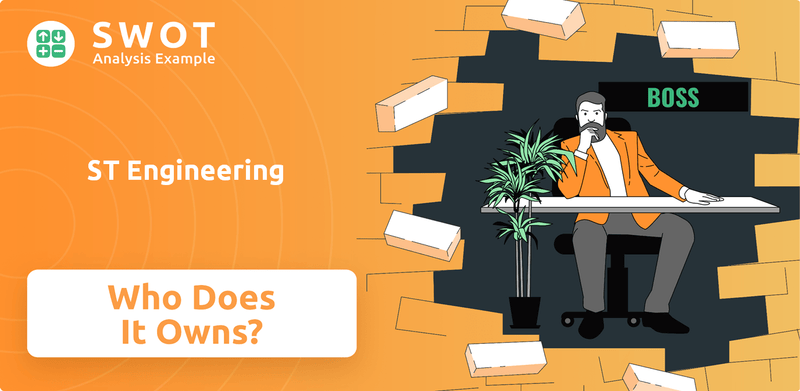
From its humble beginnings as Singapore Technologies Engineering in 1997, ST Engineering's ownership has evolved, influencing its growth and market position. Examining the ST Engineering ownership structure reveals the key shareholders, including the ST Engineering parent company and major shareholders, and their impact on the company's performance. This exploration seeks to answer questions like: Is ST Engineering a public company? Who owns ST Engineering and how does this influence its decisions? Understanding ST Engineering shareholders is crucial for anyone looking to invest or partner with this influential organization.
Who Founded ST Engineering?
The story of ST Engineering begins not with a single founder, but through the strategic consolidation of several government-linked entities. These entities were established to support Singapore's defense capabilities. The evolution of ST Engineering ownership reflects the nation's focus on self-reliance and technological advancement.
The foundational companies that would eventually form ST Engineering were created in the late 1960s and 1970s. These included Chartered Industries of Singapore (CIS), Singapore Shipbuilding and Engineering, and Singapore Electronic & Engineering. These companies were initially grouped under a holding company.
The early stages of ST Engineering were driven by the Singaporean government's vision. The government aimed to build indigenous support for the Singapore Armed Forces. This strategic approach led to the formation of various entities that later became integral to ST Engineering.
The initial entities that formed ST Engineering were established by the Singaporean government. These companies were grouped under a holding company named Sheng-Li in 1974. In 1990, Sheng-Li was renamed Singapore Technologies Holdings. This marked the beginning of a shift toward a more publicly accessible structure.
- Chartered Industries of Singapore (CIS) was established on January 27, 1967.
- Singapore Shipbuilding and Engineering (precursor of ST Marine) was established in 1968.
- Singapore Electronic & Engineering (precursor of ST Electronics) was established in 1969.
- Singapore Automotive Engineering (precursor of ST Kinetics) was formed in 1971.
- Singapore Aerospace Maintenance Co. (precursor of ST Aerospace) was formed in 1975.
By 1994, Singapore Technologies Holdings came under the state investment company Temasek Holdings. The ultimate amalgamation of ST Aerospace, ST Electronics, ST Automotive (formerly ST Kinetics), and ST Marine in December 1997 formed ST Engineering, a S$2 billion listed company. This marked the formal public listing of the combined entity on the mainboard of the Singapore Exchange. For more insights into the company's structure, you can explore the details of ST Engineering's history.
ST Engineering SWOT Analysis
- Complete SWOT Breakdown
- Fully Customizable
- Editable in Excel & Word
- Professional Formatting
- Investor-Ready Format
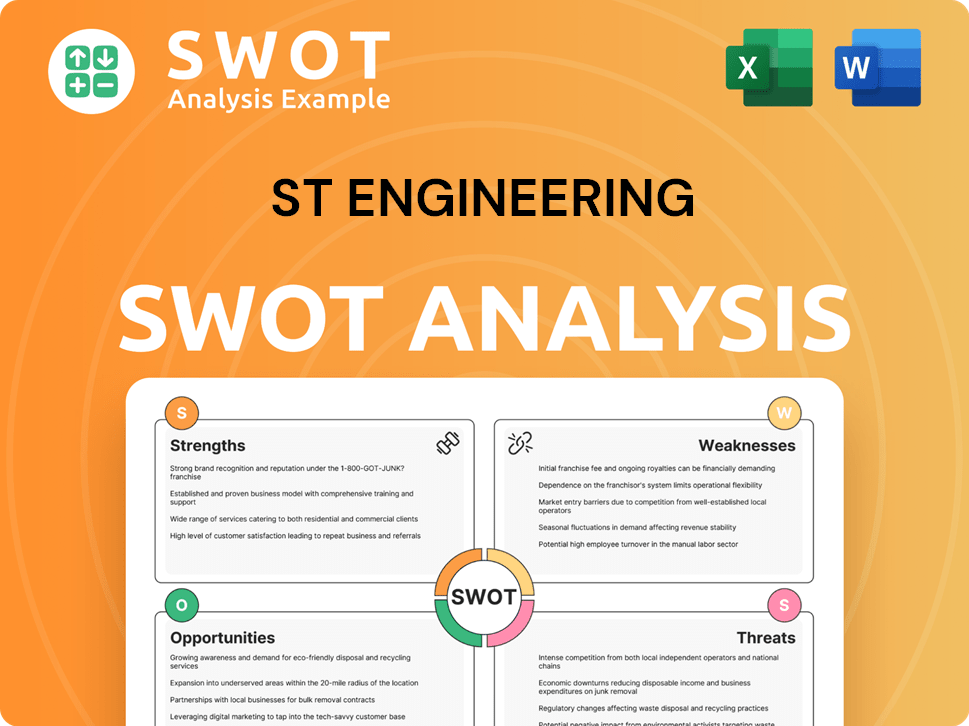
How Has ST Engineering’s Ownership Changed Over Time?
The ownership structure of ST Engineering, also known as Singapore Technologies Engineering, has evolved significantly since its listing on the Singapore Exchange in December 1997. The primary influence on this evolution has been Temasek Holdings (Private) Limited, the company's largest shareholder. Temasek's strategic role reflects the government's ongoing interest in the company, ensuring its alignment with national strategic objectives. Understanding the dynamics of ST Engineering ownership is crucial for investors and stakeholders alike.
As of December 31, 2024, Temasek Holdings, along with Vestal Investments, held approximately 50.9% of ST Engineering's total issued shares. This substantial stake makes Temasek the controlling shareholder, significantly influencing the company's strategic decisions and direction. The remaining shares are distributed among various institutional investors, funds worldwide, and retail investors, creating a diverse shareholder base. This structure ensures compliance with the Singapore Exchange's listing rules and provides access to public capital.
| Ownership Category | Stake as of December 20, 2024 | Notes |
|---|---|---|
| Private Equity Firms | 51% | Collective holding |
| Individual Investors | 36% | |
| Institutional Investors | 13% | Includes Vanguard Group, Inc. and BlackRock, Inc. |
The composition of ST Engineering shareholders includes significant institutional investors. For example, The Vanguard Group, Inc. and BlackRock, Inc. held approximately 1.9% and 1.8% of the common stock, respectively, as of December 20, 2024. Furthermore, the company maintains a public shareholding of approximately 48.54% of its issued shares (excluding treasury shares) as of February 28, 2025. This ensures compliance with SGX-ST listing rules. The market capitalization stood at $19 billion USD as of June 2025. The government's interest is further underscored by the requirement for approval from the 'Special Member,' the Minister for Finance of the Republic of Singapore (who owns one Special Share), if any entity or individual wishes to own 15% or more of ST Engineering's issued shares. This governance structure safeguards the company's strategic importance. To understand the company's origins, you can read a Brief History of ST Engineering.
Temasek Holdings is the controlling shareholder, holding a significant stake in ST Engineering.
- A diverse group of institutional and retail investors hold the remaining shares.
- The government retains strategic influence through specific governance mechanisms.
- The company is listed on the Singapore Exchange, providing access to public capital.
ST Engineering PESTLE Analysis
- Covers All 6 PESTLE Categories
- No Research Needed – Save Hours of Work
- Built by Experts, Trusted by Consultants
- Instant Download, Ready to Use
- 100% Editable, Fully Customizable
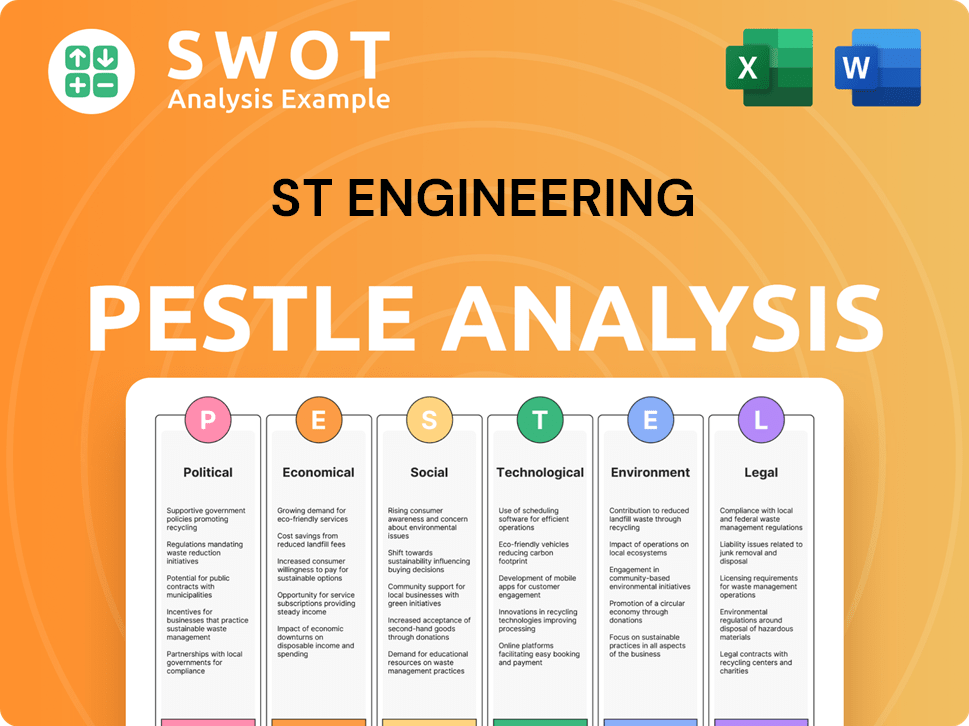
Who Sits on ST Engineering’s Board?
The Board of Directors of ST Engineering oversees the company's strategic direction and governance. As of the most recent information, the board consists of 12 Directors and 1 alternate Director. This includes 8 independent Directors, ensuring a focus on robust corporate governance and shareholder value. Key figures include Mr. Teo Ming Kian, an Independent Director, and Mr. Vincent Chong Sy Feng, the Executive Director and Group President & CEO.
Other independent directors are Mr. Kevin Kwok Khien, Mr. Philip Lee Sooi Chuen, Ms. Lien Siaou-Sze, Mr. Lim Chin Hu, Ms. Neo Gim Huay, and Ms. Ng Bee Bee. Non-Independent Non-Executive Directors include VADM Aaron Beng Yao Cheng and Mr. Ong Su Kiat Melvyn, with COL Chong Shi Hao serving as an alternate Director. Ms. Song Su-Min is also an Independent Director and became Chairman of the Risk and Sustainability Committee (RSC) on January 1, 2025. Recent changes include Mr. Lim Ah Doo's resignation as Director, effective November 10, 2024.
| Director | Role | Status |
|---|---|---|
| Teo Ming Kian | Director | Independent |
| Vincent Chong Sy Feng | Executive Director, Group President & CEO | Executive |
| Song Su-Min | Director, Chairman of RSC | Independent |
| Kevin Kwok Khien | Director | Independent |
| Philip Lee Sooi Chuen | Director | Independent |
| Lien Siaou-Sze | Director | Independent |
| Lim Chin Hu | Director | Independent |
| Neo Gim Huay | Director | Independent |
| Ng Bee Bee | Director | Independent |
| VADM Aaron Beng Yao Cheng | Director | Non-Independent Non-Executive |
| Ong Su Kiat Melvyn | Director | Non-Independent Non-Executive |
| Chong Shi Hao | Alternate Director | N/A |
The voting structure at ST Engineering generally follows a one-share-one-vote principle for its ordinary shares. However, the Minister for Finance of the Republic of Singapore holds a 'Special Share,' which grants approval power for any entity seeking to own 15% or more of ST Engineering's issued shares. This indicates a degree of government oversight and influence. Understanding the Growth Strategy of ST Engineering is crucial for investors and stakeholders alike, given the company's structure and governance.
The Board of Directors is composed of 12 Directors and 1 alternate Director, with a majority being independent.
- The Minister for Finance holds a Special Share, influencing major ownership changes.
- Recent changes include board member resignations and committee chair appointments.
- The governance structure reflects a balance of independent oversight and government influence.
- Understanding the company structure is important for anyone researching ST Engineering ownership.
ST Engineering Business Model Canvas
- Complete 9-Block Business Model Canvas
- Effortlessly Communicate Your Business Strategy
- Investor-Ready BMC Format
- 100% Editable and Customizable
- Clear and Structured Layout
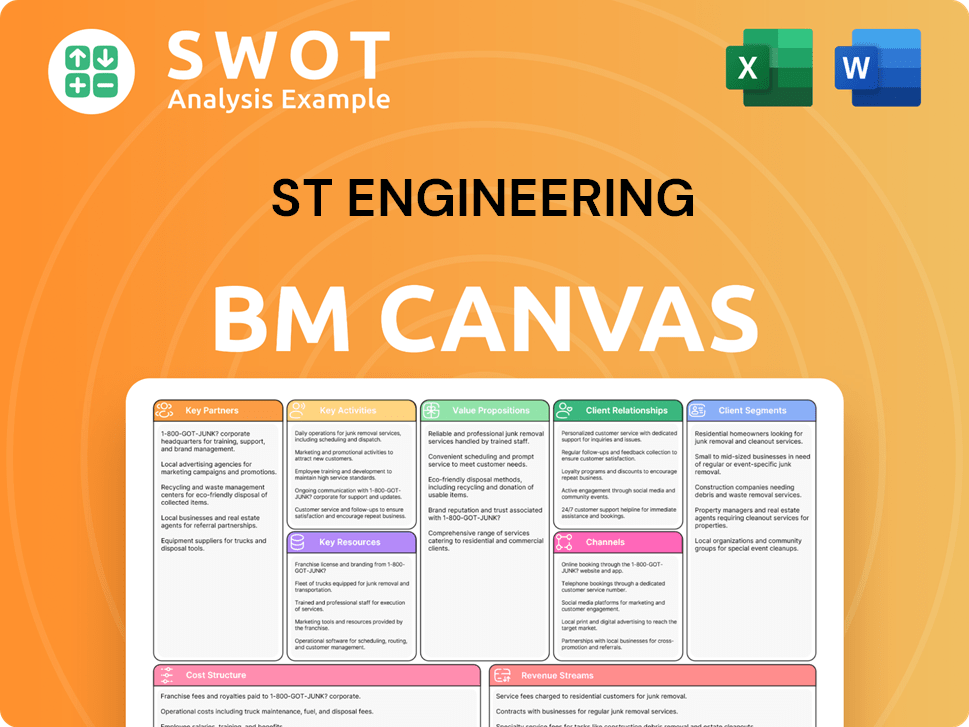
What Recent Changes Have Shaped ST Engineering’s Ownership Landscape?
Over the past few years, ST Engineering has shown robust financial performance, which could influence its ownership profile. The company's revenue hit a record $11.28 billion, with a net profit of $702 million in FY2024. Its order book nearly doubled from S$14.4 billion in 2020 to S$28.5 billion by the end of 2024, indicating strong future revenue potential.
ST Engineering has also been focusing on shareholder returns, announcing a progressive dividend plan. The total dividend is set to increase to 18 cents per share for FY2025, up from 17 cents in FY2024. From FY2026 onwards, the company plans to pay out about one-third of its year-on-year increase in net profit as incremental dividends. The company is targeting revenue of $17 billion by 2029, with significant contributions expected from its defense and public security, and commercial aerospace businesses.
| Metric | Value | Year |
|---|---|---|
| Revenue | $11.28 billion | FY2024 |
| Net Profit | $702 million | FY2024 |
| Order Book | S$28.5 billion | End of 2024 |
| Dividend per Share (Proposed) | 18 cents | FY2025 |
The ownership structure of ST Engineering is largely defined by Temasek Holdings, which held approximately 50.9% of the shares as of December 31, 2024. The company secured about $4.3 billion in new contracts in Q4 2024, including major deals in Commercial Aerospace and Defence and Public Security. These developments, along with a focus on its digital business and smart mobility, are expected to drive future growth and potentially attract further institutional investment. Temasek's significant stake ensures stability and alignment with national interests, shaping the dynamics of ST Engineering ownership.
Record revenue and strong order book growth indicate positive financial health. Progressive dividend plan signals commitment to shareholder returns. Strategic focus on defense, public security, and commercial aerospace for future growth.
Temasek Holdings remains the major shareholder, ensuring stability. New contracts secured in key sectors support long-term growth. Focus on digital business and smart mobility could attract new investors.
Targeting $17 billion in revenue by 2029. Continued expansion in key sectors is expected. Potential for increased institutional investment due to growth prospects.
FY2024 net profit of $702 million. Order book nearly doubled to $28.5 billion. Proposed dividend increase to 18 cents per share for FY2025.
ST Engineering Porter's Five Forces Analysis
- Covers All 5 Competitive Forces in Detail
- Structured for Consultants, Students, and Founders
- 100% Editable in Microsoft Word & Excel
- Instant Digital Download – Use Immediately
- Compatible with Mac & PC – Fully Unlocked
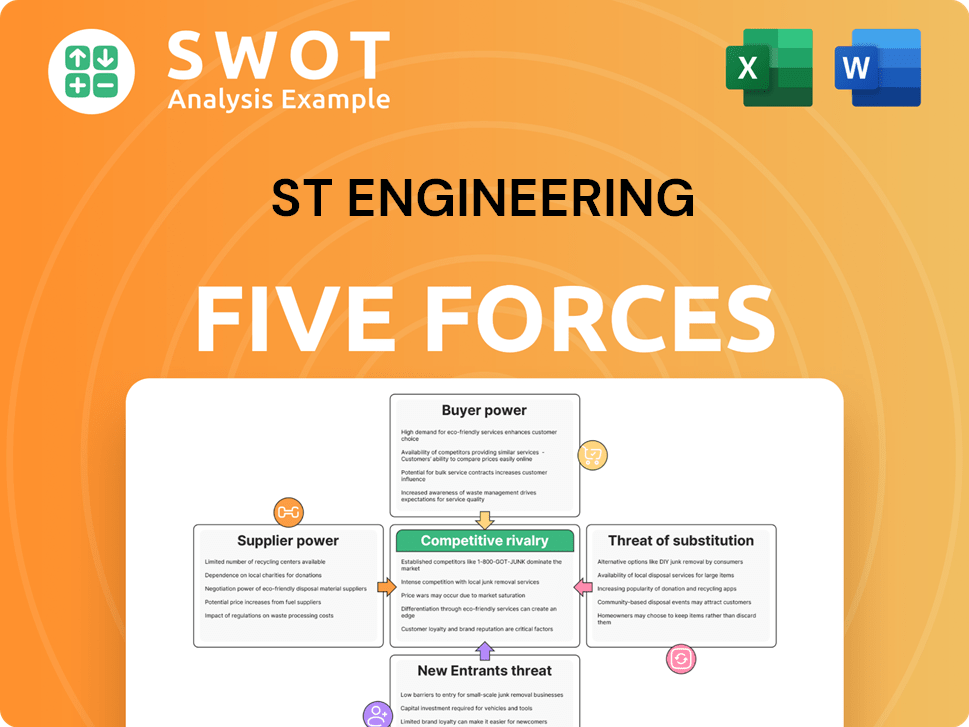
Related Blogs
- What are Mission Vision & Core Values of ST Engineering Company?
- What is Competitive Landscape of ST Engineering Company?
- What is Growth Strategy and Future Prospects of ST Engineering Company?
- How Does ST Engineering Company Work?
- What is Sales and Marketing Strategy of ST Engineering Company?
- What is Brief History of ST Engineering Company?
- What is Customer Demographics and Target Market of ST Engineering Company?
Disclaimer
All information, articles, and product details provided on this website are for general informational and educational purposes only. We do not claim any ownership over, nor do we intend to infringe upon, any trademarks, copyrights, logos, brand names, or other intellectual property mentioned or depicted on this site. Such intellectual property remains the property of its respective owners, and any references here are made solely for identification or informational purposes, without implying any affiliation, endorsement, or partnership.
We make no representations or warranties, express or implied, regarding the accuracy, completeness, or suitability of any content or products presented. Nothing on this website should be construed as legal, tax, investment, financial, medical, or other professional advice. In addition, no part of this site—including articles or product references—constitutes a solicitation, recommendation, endorsement, advertisement, or offer to buy or sell any securities, franchises, or other financial instruments, particularly in jurisdictions where such activity would be unlawful.
All content is of a general nature and may not address the specific circumstances of any individual or entity. It is not a substitute for professional advice or services. Any actions you take based on the information provided here are strictly at your own risk. You accept full responsibility for any decisions or outcomes arising from your use of this website and agree to release us from any liability in connection with your use of, or reliance upon, the content or products found herein.